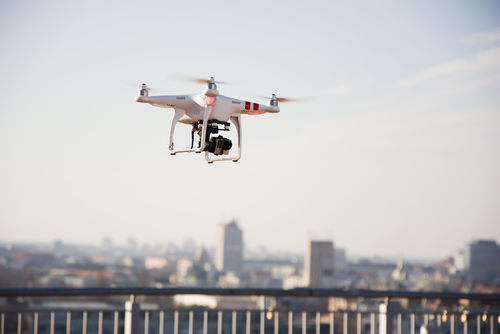Yesterday, the Federal Aviation Administration announced three partnerships with companies to expand the operation of unmanned aerial vehicles (UAVs) in an initiative the agency is calling the Pathfinder program.
U.S.-based drone maker PrecisionHawk will be exploring the possibilities of flights over agriculture while testing tracking and a system for drones and planes to remain aware of each other in flight to avoid collisions. CNN will be testing the use of drones for newsgathering in urban areas where drones will remain in the line of sight of operators. BNSF Railroad, owned by Warren Buffet’s Berkshire Hathaway, received permission to test drone operations outside of the operator’s visual line of sight. The company will “explore command-and-control challenges of using UAS to inspect rail system infrastructure,” the FAA reported.
“Government has some of the best and brightest minds in aviation, but we can’t operate in a vacuum,” said U.S. Transportation Secretary Anthony Foxx. “This is a big job, and we’ll get to our goal of safe, widespread UAS integration more quickly by leveraging the resources and expertise of the industry.”
To that end, Pathfinder will allow these corporate entities to research operations that push the boundaries of the recent draft rules released regarding small unmanned aircraft, namely by operating both within and without the visual line of sight requirements currently mandated by the FAA.
“Even as we pursue our current rulemaking effort for small unmanned aircraft, we must continue to actively look for future ways to expand non-recreational UAS uses,” said FAA Administrator Michael Huerta, who announced the initiative at a conference held Wednesday by the Association for Unmanned Vehicle Systems International. “This new initiative involving three leading U.S. companies will help us anticipate and address the needs of the evolving UAS industry.”
This effort is also the first step in realizing some companies’ grander aspirations for drone use, such as the package delivery applications being pursued by Amazon. That being said, the information gathered by these companies will merely provide data to inform future FAA regulations, which are still pending and may only approve broader operations in a few years. Other companies looking into similar applications that are beyond the scope of current draft regulations would still need to apply for and receive a Section 333 exemption from the FAA. While about 300 of these requests have been granted, the agency has received repeated criticism for an exceptionally slow and sometimes mystifying review process.
“The impact of the Pathfinder Program could be profound for several reasons — perhaps most importantly, it shows the FAA is serious about moving quickly to safely and practically integrate commercial drone use in the U.S.,” said Anthony Mormino, senior legal counsel at Swiss Re. “Allowing drone flights beyond the sight of a drone operator is considered the key to unlocking the true potential of commercial drone use. This collaboration could impact the future rules promulgated by the FAA regarding the line of sight requirement for commercial drones.”
Such developments could also significantly impact insurers. As discussed in “Drones Take Flight,” the April cover story of Risk Management magazine, one of the most promising near-future applications for UAVs could be in the insurance industry in the wake of natural catastrophes or other major claim events. “Reducing or eliminating the visual line of sight limitation on commercial drone use will allow insurance companies to employ UAVs to their fullest extent in insurance underwriting and claims management,” Mormino said. “Consider that the FAA has already granted a number of insurance companies permission to test and use UAVs for insurance inspection purposes. These companies include AIG, State Farm, Erie Insurance Group, and USAA.
They plan to use UAVs, for example, to more quickly process insurance claims after natural disasters by allowing them to inspect damage —especially in remote locations—in real time.
Insurers also plan to use UAVs to obtain imagery and data for use in underwriting, such as roof inspections. Until the FAA mitigates the visual line of sight limitation, however, the foregoing insurance uses for UAVs will remain drastically limited. Success for the FAA’s new Pathfinder program would open the door to potentially even larger scale use of UAVs by insurance companies.”
The implications for insurers also extend to the products and pricing offered. “First, the current dearth of UAS loss data makes it difficult for insurance companies to properly price insurance policies covering drone use,” said Carol Kreiling, senior claim manager at Swiss Re. “It is therefore no surprise that only a handful of insurers actually issue stand alone drone insurance coverage, such as Zurich Insurance in Canada, and Tokio Marine in the Lloyd’s of London market. An increase in commercial use of drones in the US could provide a steady flow of data that would allow more insurers to price and issue coverage for use of UAS. On the other hand, if the Pathfinder program’s goals are fulfilled—to find ways to safely use UAVs outside a pilot’s visual line of sight—increased remote use of drones could raise risk profiles for insurance coverage.
”
At the conference, Huerta also announced a new smartphone app called B4UFLY, designed to help model aircraft and UAS users know if it is safe and legal to fly in their current or planned location by pairing geolocations with the relevant restrictions and requirements.
For more about drones, UAV regulations, and the potential impact these machines may have on the insurance industry, check out “Drones Take Flight,” the April cover story of Risk Management magazine.


